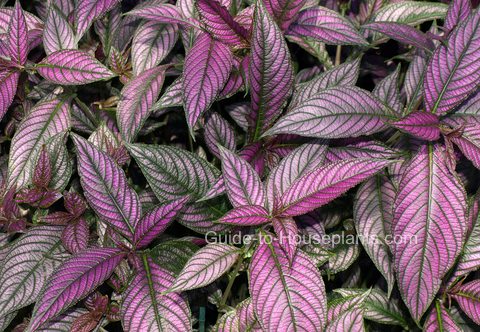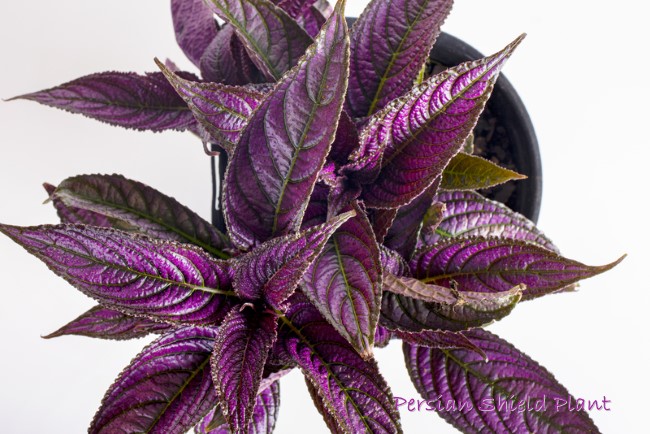Persian Shield Plant Care
Persian Shield is a stunning house plant that's a cinch to grow with minimal attention. Its colorful, shimmery leaves are every bit as attention-getting as most flowering plants, plus it's easy to please.
Can't get enough of this tropical beauty? Pinch off a stem anytime to propagate a new plant. Keep pinching and you'll have a succession of new house plants. This is a plant that keeps on giving.
 Iridescent leaves make Persian Shield a standout among your plant collection.
Iridescent leaves make Persian Shield a standout among your plant collection.Get to Know Persian Shield Plant
Persian Shield is known botanically as Strobilanthes dyerianus. It has origins in Burma (officially, the Union of Myanmar), where it thrives in the tropical climate.
Those lance-shaped leaves are deep purple and pink with a shimmer of silver. Expect the colors to lighten as the plant ages, but this isn't a problem.
Will it bloom? You may see funnel-shaped, light-blue flowers appear in summer, but they pale in comparison to the magnificent foliage. Pinch off the flower spikes as soon as you see them because they weaken the plant. Those beautiful metallic leaves are the real attraction, anyway.
How big does Persian Shield plant get? It may reach up to 2 ft (60 cm) or more in height.
This soft-stemmed shrub is fast-growing. Cut Persian Shield back in spring when it becomes leggy. Pinching off its stem tips in spring and summer will encourage branching and create a fuller, bushier plant.
Pruning Tip
Cut a stem at an angle, just after a node (the place where a leaf is attached to the stem). Cutting here will force the stem to branch out.
Persian Shield Problems, Solutions and Answers
Brown crispy leaves are caused by dry air. This tropical native wants moist air to look its best. Don't worry, there are easy ways to raise the humidity around it. I often use pebble trays with water or a cool-mist room humidifier. Both options are low-cost and well worth it to keep your tropicals healthy.
Repot in spring when the roots have filled the pot -- probably every couple years. Use a pot with drainage holes to prevent soggy potting mix, which can lead to root rot.
Make more plants. This beautiful plant will get leggy over time. By propagating stem cuttings -- which is easy to do -- you can replace the plant and keep it going indefinitely.
Something bugging your plant? Watch for spider mites that are attracted to houseplants, especially in winter. These pests are so tiny, you'll likely notice the fine webbing between stems and leaves. Wash off an infested plant with lukewarm water to remove them. Cut off badly infested leaves and treat your houseplant with insecticidal soap. Raising the humidity around your houseplants may help to prevent an infestation.
 Persian Shield has gorgeous leaves, rivaling many flowering plants. Photo ©Tony Bosse
Persian Shield has gorgeous leaves, rivaling many flowering plants. Photo ©Tony BossePersian Shield Care Tips
Light: Bright indirect light. If you move Persian Shield outdoors for the summer, keep the plant shaded from hot, direct sunlight.
Water: Water thoroughly and allow the soil to dry out a bit between waterings. Keep soil drier in winter months, but do not allow it to dry out completely. Use distilled water because tap water often contains chlorine, which leaves white spots on the foliage.
Humidity: High (about 50% relative humidity or higher). The most efficient way to boost moisture for indoor plants is with a cool-mist room humidifier. Brown leaves are a symptom of dry air.
Temperature: Normal room temperatures 65-75°F/18-24°C. Strobilanthes dyerianus is a tender perennial. Hardy only in Zone 10, so if it summers outdoors, don't worry, it can take the heat. But bring it back in if the temperature drops below 60°F/16°C at night.
Soil: Any good-quality, all-purpose potting mix
Fertilizer: Feed every 2 weeks spring through fall with a balanced (such as 10-10-10 N-P-K) water-soluble fertilizer. Only fertilize when watering to avoid fertilizer burn.
Propagation: Take 4 in (10 cm) stem tip cuttings in spring and root them in moist soil. Propagating the cuttings requires a heat mat for best results; this tropical native likes to stay warm. Persian Shield cuttings should root in about 2-3 weeks.


